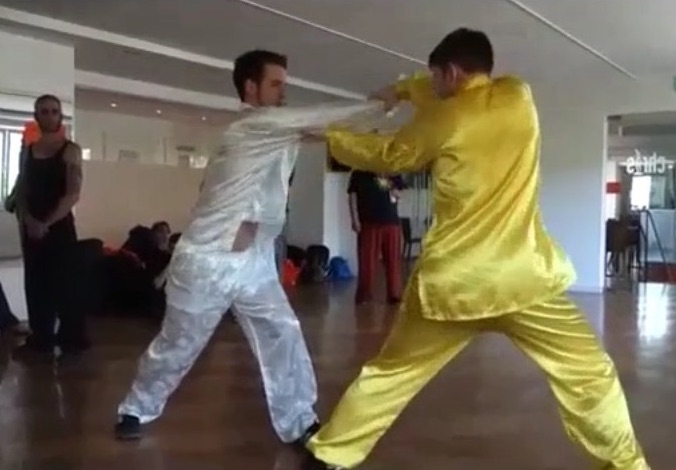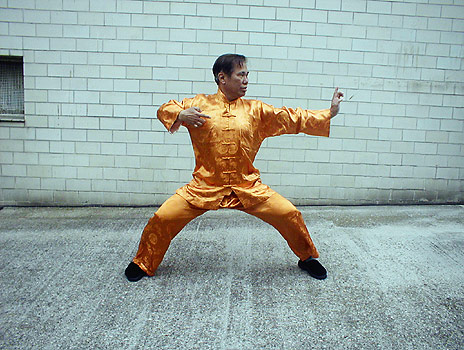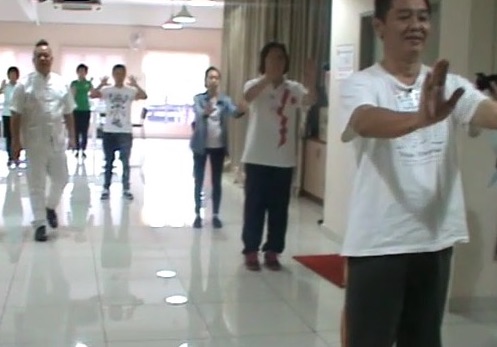SELECTION OF QUESTIONS AND ANSWERS
NOVEMBER 2017 PART 3

Practice a combat sequence very well and apply it on opponents in free sparring
Question 1
How should our students train to defeat opponents in free sparring?
— Sifu Chris Didyk, Shaolin Wahnam USA
Answer
An excellent method is to train a combat sequence very well, and when our students are very skillful, apply it on opponents in free sparring. This is what I call an "invincible method". I used this method in my younger days when I went out to look for opponents in free sparring, and I remained undefeated.
Let us represent this method using algebra. Let us suppose opponents use A, B, C and D. A, B, C and D represent random hitting and kicking with some shoots and pin downs, like punching wildly, kicking frantically, rushing in with a shoot, and pinning an opponent down.
Our students use E in free sparring. E represents a trained combat sequence. We have many combat sequences in our school. Let us choose a simple one composed for this purpose, which is a horse-riding punch, a hanging fist and a snap kick, as in the patterns "Precious Duck Swims through Lotus", "Reverse hanging of Golden Lotus" and "Yellow Bird Drinks Water".
Our students must be well trained in E, which is his chosen combat sequence. They must have good form, speed and force. So, as soon as opponents use A, B, C and D, our students just apply E on them. They will find the opponents being pressed against a wall.
If our students are silly enough to use A, B, C or D, like bouncing about punching and kicking wildly, or using shoots, pin-downs or other martial art techniques which they have hastily learned, they will be easily defeated by their opponents.
If our students use E, i.e. their trained combat sequence, on their opponents, even when their opponents are better than them, they can still beat their opponents! This is ridiculous, just as many things in our school are ridiculous, but true. Our algebra will explain why.
Their opponents are expert in A, B, C and D. Our students beat these otherwise experts in E. The opponents have no chance to use their expert skills and techniques.
As an analogy, let us suppose that a mathematics professor, a history professor, a doctor and a lawyer, whose skills are represented as A, B, C and D, compete with a basketballer in throwing a ball into a basket, which is represented as E. The basketballer will beat the others easily. The others have no chance to demonstrate their skills.
Question 2
My opponent is a Praying Mantis Kungfu master who has a lot of experience in free sparring. Can I use the same method to beat him?
Answer
Yes, you can. If he is good at A, B, C and D, which are Praying Mantis skills and techniques in free sparring, and you train in E, which Praying Mantis Kungfu masters do not know how to counter, you can use this "invincible strategy" to beat him. But there are three considerations you have to overcome:
- Opponents using non-kungfu martial arts may have no techniques in their repertoire to counter certain kungfu attacks. For example, if you kick a Boxer, or catch the kicking leg of a Taekwondo exponent, the Boxer or the Taekwondo exponent would have no techniques in his art to counter you. But there are techniques in Praying Mantis Kungfu to counter any kungfu attack, unless a Praying Mantis exponent does not know them.
- You must train your combat sequence so well that even if the Praying Mantis Kungfu opponent knows how to counter your attacks, he cannot do so because you are so skillful.
- You should not have free sparring with the experienced Praying Mantis Kungfu master now. You do so after you have completed your 30-opponent programme when you know you can beat him.

Non-kungfu martial artists have no techniques in their repertoire to counter sophisticated chin-na techniques
Question 3
Can you please explain why a non-kungfu combatant has no techniques in his repertoire to counter certain kungfu attacks?
Answer
Actually martial arts like Boxing, Taekwondo, Karate, Judo, Muay Thai and Wrestling are sports, not combat arts with no rules bared.
According to Boxing rules, you cannot kick a Boxer, or attack him below his belt or behind his back. According to Taekwondo rules, you cannot catch the kicking leg of your opponent. According to Karate rules, you cannot grip your opponent. According to Judo, Muay Thai or Wrestling rules, you cannot poke your opponent's eyes or smash his groin.
But in kungfu there are no rules, Free sparring means free sparring without any rules. You can strike a Boxer behind his back, catch the kicking leg of a Taekwondo exponent, applies chin-na techniques on a Karateka, poke your fingers or smash the groin of your Judo, Muay Thai or Wrestling opponents. In the non-kungfu martial arts, free sparring means free sparring following safety rules of the respective arts.
Practitioners of these non-kungfu arts often forget about this fact. If a kungfu exponent strikes a Boxer behind his back, or catch the kicking leg of a Taekwondo exponent, for example, the kungfu exponent is often told that he is not allowed to do that.
But in a real fight, for which kungfu is practiced, there are no rules. Practitioners of non-kungfu martial arts often have no techniques in their arts to counter attacks that fall outside their safety rules.
Question 4
Can you please explain what you mean by saying that even if a Praying Mantis Kungfu exponent knows the counter, he may not be able to do so in free sparring?
Answer
Let us take the example of a combat sequence consisting of a horse-riding punch, a hanging fist and a snap kick.
When a Praying Mantis Kungfu combatant moves in to attack you, almost irrespective of what form of attack, you shiftly move to his right side and execute a sideways horse-riding punch, like "Precious Duck Swims through Lotus". He knows, in theory, that he can defend against the low attack by shifting hack his body, like using "Slant Body Swing Hand" in the Eighteen-Collection Set. But you are so fast and precise in your attack that before he can shift back his body, you have hit him
Immediately you swing your fist at his head using a reverse hanging fist, like "Reverse Hanging of Golden Lotus". Your opponent knows that he can ward off the top attack using, for example, "Seven-Star Hook Hand", but before he can do so, you have hung your fist on his head.
Immediately you kick at his groin, but for compassionate reason, you kick at his abdomen using a snap kick, like "Yellow Bird Drinks Water". Your opponent knows he can jumps back to avoid your kick, like using "Jump Step Avoid Force", but you are so skillful that before he can do so, you have kicked him.
Such a situation occues between masters in combat, or even amongst our students. A master knows the counter against any attack, but he is still defeated because the other master is more skillful. Our kungfu students learn the counters against basic attacks, like in the 16 basic Shaolin combat sequences, or the 12 basic Taijiquan combat sequences, but they may not be skillful enough to apply them in free sparring.

Shooting Arrows Left and Right
Question 5
Can you please tell us more about the 30-opponent programme?
Answer
The 30-opponent programme is actually a secret training method in our school, but I shall briefly explain. Others may not understand the explanation.
You line up your 30 opponents from 1 to 30, with the least combat effectice at 1 and the most combat effective at 30.
At the start of the programme you have 95% chance of beating your opponent at 1, but your opponent at 30 has 95% chance of beating you. At he end of the programme, you will have reverse the possibilities; you will have 95% chance of beating the opponent at 30.
Suppose you are now at 20. As you have faithfully followed the programme, you just beat your opponent at 20 with a 95% chance of winning. If you go immediately to meet your opponent at 30, you have only 40% chance of beating him, and he has 60% chance of beating you. So you don't engage him in free sparring now. As a scholar-warrior, you fight him orly when you are very sure of winning.
So you faithfully continue your programme free sparring progressively from 21 to 30. By the time you reach 30, you will have 95% chance of beating your opponent.
Question 6
My stepfather used to molest me, and years later, my little brother and other kids
My mother knows about this, and I suspect she even saw some of it, but did nothing except telling him he was wrong.
I am being treated by Sifu Andrew for all my issues, but his latest advice has been to leave the house, which I am planning to do soon.
I have argued about this with my mother for the past 4 or 5 years. She does help me, but protects him and defends his opinions a lot more. Lately they have been attacking me.
I ask you this because Sifu Andrew is busy enough and already helps me a lot, and because I find you extremely wise in human matters.
— Name and Country Withheld
Answer
Sifu Andrew Barnett is a very good teacher and healer. He has helped many people overcome their problems.
I totally agree with his advice that it is best for you to leave the house. It is best for both you and the other party.
Here is my advice for your other question.
You can tactfully tell your mother again about your little brother and other kids. But it is important not to press her for any commitment. Have pity on her, and be kind to her. Let her make any decision she thinks is best.
In an ideal world, every one is kind and loving. But you have to accept that our world is far from being ideal. There are a lot of things that happen that ideally should not happen, and you have to admit that you are not in a position to change them.
Not only you must be friendly to your mother, you must be kind to her at all times. You have only one mother.
Be generous to your stepfather. Forgive him for whatever wrong you believe he may have done. It is actually more for your sake than for his that you must forgive.

In your regular practice, train at about 30% of your level at a regional course or an intensive course taught by Grandmaster Wong
Question 7
For a student who worked on a biology project I had my blood pressure measured at school. It was a bit high. Should I do something about this and change my routine? I am now doing One Finger Zen mostly and enjoying it tremendously.
— Stfu Roeland Dijkema, Shaolin Wahnam Netherlands
Answer
It is normal for some people to have higher blood pressure than the average. If their blood pressure is like normal people, it will be too low for them. How do we know that their higher blood pressure is normal for them. Simple. They don't have symptoms of high blood pressure of average people.
Even if they have, it may not be a health issue for them. For example, some people, like the Dutch, are taller than average. If they are in places where the height is average, they may have to bend their bead when they pass overhead beams. At the Copthrone Orchid Hotel in Penang, for example, I used to joke telling tall people not to break overhead beams when they walk past them.
An effective exercise for regulating blood pressure is "Shooting Arrows" from the 18 Lohan Hands. If your blood pressure is normal for you, though it may appear high for average people, the exercise will increase your internal force, especially for your One-Finger Zen.
Question 8
How do we prevent over-training in our chi kung training?
— Christian, USA
Answer
In your regular practice, train at only about 30% of the level you did at a regional course or intensive course with me. An effective way is not to enter too deeply into a chi kung state of mind.
If someone earns $2000 a month, 30% of $2000 is too little. But if he earns $100,000 a month, 30%, which is $30,000 a month, is a lot of money. Transferred to chi kung benefits, if an average chi kung practitioner gets 2000 units of benefits a month, you get 30,000 units of benefits a month working at only 30%, which is a lot of benefits.
Is it fair to say that if an average chi kung practitioner gets 2000 units of benefits a month, our students working at 100% will get 100,000 units of benefits a month?
100,000 units of benefits is 50 times more than 2000 units of benefits. If an average chi kung practitioner can consciously generate an energy flow after 50 days of practice, it is very good result.
Our students at my regional courses or intensive courses can generate an energy flow on the very first day of their chi kung training! Hence, it is fair to say that our students are at least 50 times more effective than average chi kung students! Hence, if average students get 2000 units of benefits per month, our students working at 100% can get 50 times more, which is 100, 000 units of benefits.
But 100,000 units of benefits will be too much for the physical body of our students to support. Hence, it is recommended that they practice at about 30% of the level they did at my regional courses or intensive courses.
Why do I teach at 100% and then ask students to practice at 30% on their own? It is because I teach many years of benefits in just a few days, or even a few hours.
If you have any questions, please e-mail them to Grandmaster Wong via his Secretary at stating your name, country and e-mail address.
LINKS
Selected Reading
- We have Become Ridiculously Effective in our Training
- Aims and Objectives of Practicing Kungfu
- Northern Shaolin Seven-Star Set
- Learning Tantui Advanced Combat Sequence 1
- Change from Worrying about How to Defend against Oppnenent's Attack to Letting him Worry about How to Defend against your Attack
